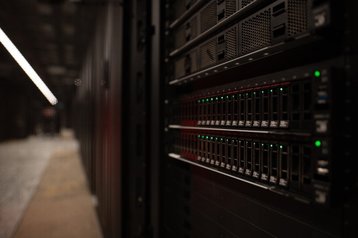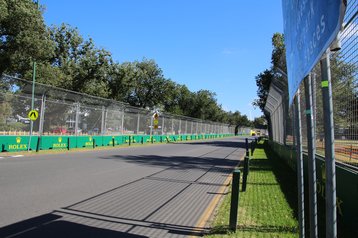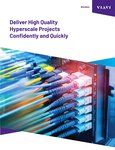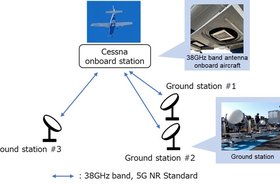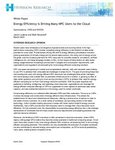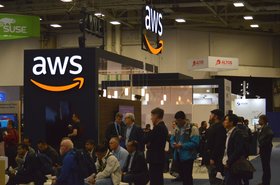The rumbling bass line from Fleetwood Mac’s The Chain. Murray Walker shouting ‘Go, Go, Go!’. The carnage of screaming supercharged engines and opening lap pile-ups. For many UK sports fans of a certain vintage, the BBC and ITV’s television coverage of Formula 1 (F1) is as iconic as the Match of the Day theme song or the screams of ‘Golazzo!’ on Channel 4’s Football Italia series.
Today, Formula 1 remains one of the most-watched sports in the world. Every season, each race draws in tens of millions of viewers globally. But behind the scenes, F1 has had a change in approach.
Instead of broadcasting the races directly at the track, the organization is doing it remotely, and more efficiently. “We decided, strategically, that we wanted to split our operation,” explains Pete Samara, director of innovation and digital technology at Formula 1.
Samara is speaking from Biggin Hill, UK, the home of Formula 1’s Media and Technology Centre (M&TC), where the company was giving DCD a tour of the facility.
“We felt technology caught up as an enabler and allowed us to do what we couldn't do before, which is to get connectivity around the world reliably," he says.
It’s from this very site at Biggin Hill, which was once a primary RAF fighter base during World War II, that Formula 1 broadcasts its world feed, with the support of Lenovo’s technology infrastructure.
Simply put, all the footage from the racetrack is broadcast from Biggin Hill onto TV screens across the world, along with audio, augmented graphics, and virtual advertising.
Lenovo Partnership
Since 2022, Lenovo has been the official partner of Formula 1, providing technology and IT support across the sport.
The company offers an array of its technology to F1, including systems, tablets, servers, and workstations for the sport to use for analysis and broadcast packages.
On a typical race weekend, up to 500 terabytes of data are collected and transmitted by two dedicated 10-gigabit critical fiber pipelines back to mission control at the M&TC.
According to the team, the largest latency observed is 300 milliseconds from Australia, a time which isn’t noticeable. Given that cars can have up to 400 sensors on board at one time, data is essential for the sport to winning.
On top of this, there are multiple cameras on each car, while there are also several scattered across the length of the circuit. Every millisecond counts in F1, which explains the need for so much equipment at the event.
Moving to remote
Traditionally, Samara explains, Formula 1 broadcasters would pack up all their filming equipment and travel en masse across the globe.
This presents a couple of notable issues. Firstly, it costs a lot of money to ferry hundreds of people and multiple vehicles full of equipment.
Secondly, it’s not very sustainable, something that F1 has publicly tried to address in recent years. “Pre-Covid we were at the track, post-Covid we are here [at Biggin Hill],” explains Samara, noting that since 2020 the sport has grown its operation remotely.
“This was a vision we had four or five years ago and was accelerated by Covid in about three months when we thought it would take three years. We were able to implement this last year.”
Samara notes that because of the pandemic, the sport took the opportunity to cut the fiber cable at the racetracks and took it to the ETC (Event Technical Centre) instead.
He says that this simplifies the whole process, and allows for the equipment to stay at the site rather than constantly traveling from one circuit to another.
“So effectively, people here are sitting on the same chair they were when they were in Australia, but now they're in another building thousands of miles away.” On a race day, a team of around 140 people operates the control panel at the site, known as the ETC or “Mission Control,” which Samara says is the core system.
Those at Biggin Hill will be monitoring the race footage closely in the main TV gallery room, which has 415 multi-view monitors, and thousands of screens. It’s from this hub, that the F1 team can focus on the narrative that the race builds, for example, the battle for first place, or podium spots. It is storytelling, as much as it is livestreaming.
On top of this, there are another 130 or so crew members that will still be on track, he adds, but a lot of the legwork with regards to the broadcasting is done back in the UK.
“Imagine that crew was at the track normally, pre-Covid. So it’s a significant change for us from a sustainability point of view, which was one of the main reasons we did this.”
To support the broadcasting side of things, there’s a fully functional physical and virtual studio with a green screen.
What goes into setting up the track?
While the ETC in Biggin Hill controls the broadcast operation for the world feed, there’s still a significant amount of work that needs to be done trackside for the operation to run smoothly.
Ten days before the start of each race, Formula 1 will enter the city to begin the build of its ETC at the track circuit, taking five days to build.
“Our first boots on the ground arrive about 10 days before the chequered flag,” Chris Roberts, director of IT at Formula 1, tells DCD. “They bring with them a lot of external rig items, such as the fiber cables that go around the track.”
One of the key cogs of this build is the construction of a fiber network around the racetrack, typically around 58 km (36 miles) in length, along with 38 antennas that enable two-way transfer of data between cars.
The installation of the fiber cables is connected to the Tata Communications backbone, which provides F1 its own private network, which is then connected to two 10GB fiber lines. Tata is the official broadcast connectivity partner for the sport.
These two fiber pipes are used to transmit the data gathered at the ETC and then shared to Lenovo’s data center at the M&TC.
Preparing the fiber
Roberts says that the fiber installation around the track starts immediately from when they arrive at the track and can take up to three to four days, with the ETC fired up three days before the race starts.
Races in the Formula 1 calendar are usually every two weeks, but there are multiple times during a season when races are held back-to-back. Because of this reason, there are two ETC structures in place, says Roberts.
“So as you've got back-to-back race events, we've got two structures that leapfrog each other if we haven't got time to decommission the fiber cables, but we've got only one set of the technical equipment," he says.
“There are two sets of fiber infrastructure that leapfrog each other. Fiber is rigged, commissioned, used, de-rigged, and then sent to the next required event."
The technical equipment is completely de-rigged on the Sunday night of race day and put on the back of a lorry in the early hours of Monday morning before being flown out in the afternoon and is then back at the track Tuesday at the next event.
With races returning in the future to the same location, Roberts explains that engineers know where to re-install a fiber network.
“We work with the local circuits and will carry out a cable run, so there are diagrams for workers in a manual. They will follow their guide and the cables get pulled in and then connected to several nodes that are based around the circuit.”
These nodes are connected to cameras, timings, and telemetry systems on the backbone of the network and fed back to the ETC.
As for the fiber, it’s temporary, adds Samara. “It’s our fiber and it’s fully temporary, so we overlay on the track everywhere in the world, so we don't use anything local. "The whole point of us having our own infrastructure that's temporary is that it allows us to move from race to race.”
Data centers are required
For such an operation to work smoothly, there’s an awful lot of data that needs to be processed.
Data centers are essential for this, with F1 team McLaren telling DCD last year that it transports portable data centers alongside its cars to every race. Formula 1’s ETC also houses a data center of its own that travels to every event. But away from the track, it’s no surprise there’s an onsite data center located at Biggin Hill.
The data center consists of 65 racks, and these support the broadcasting that you see on TV such as the graphics engines. The data center also supports the IT hardware, which includes timing and telemetry systems.
F1 says that the data center can store up to ‘a few terabytes.’ “On the data center side, the idea was to provide a space that is flexible, scalable, and where we could bring new technologies to bear. So there's a massive fiber infrastructure around this building to support this,” said Roberts.
In the past, there have been issues to contend with, including a core network outage.
“In the last year it’s been pretty stable, but if we go back a bit further we had an entire core network outage in 2022,” admitted Lee Wright, senior manager, networks & IT operations at F1.
“Our network has a 30-second warning, which they put out to the production team and they hit the disaster recovery button, but the world didn’t notice.” The incident occurred during the practice session of a race back in 2022, but was fixed within 10 minutes, added Wright. Although this was unplanned, the team carries out drills to prepare for such outages regularly to test recovery skills.
Only a select few are allowed to enter the data center at M&TC, adds Wright, who says that those granted access have to go through several levels of approval.
“Data center security is a priority for F1 for obvious reasons so we maintain it with centralized access control. The main doors to the data center at the M&TC have card access control, as does each individual cabinet and the Corporate room. Access is governed by a strict process managed by our physical security team.”
Technology to keep up with the demand
The rise of Formula 1 in recent years, helped by TV shows such as Netflix’s Drive to Survive, means that more and more people will continue to watch the sport, regardless of where they are or the location the race is happening.
And while you’d think much of the workforce would miss the regular travel across the world, that’s not been the case, says Roberts.
“We have found that, for some people, travel does not suit their current lifestyle but they still want to be part of Formula 1," he says. "Remote operations have allowed great talent to remain within the sport and contribute without the need to travel around the world.”
Maybe in the future, it will even be possible to achieve latency lower than 300 milliseconds from Australia, although nobody would notice anyway.
With a new season now underway, the team at Biggin Hill will likely be hoping to log a new personal best. “Records are there to be beaten,” as the great Michael Schumacher once said."



